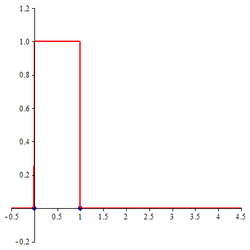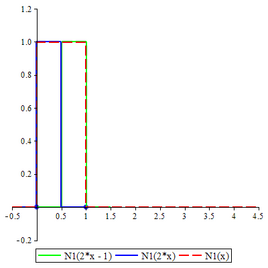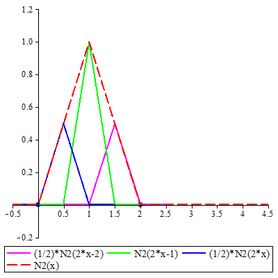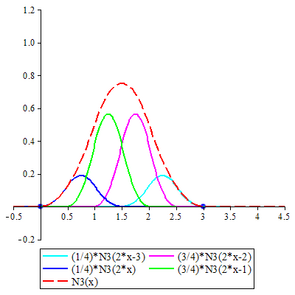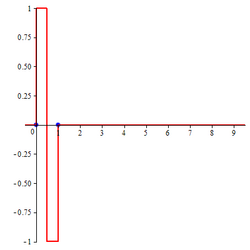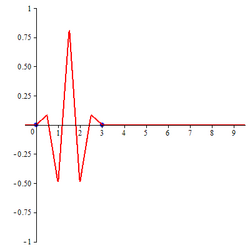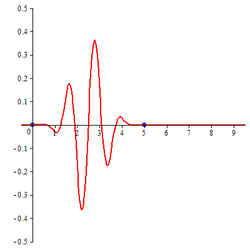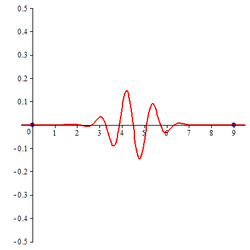Spline wavelet
In the mathematical theory of wavelets, a spline wavelet is a wavelet constructed using a spline function.[1] There are different types of spline wavelets. The interpolatory spline wavelets introduced by C.K. Chui and J.Z. Wang are based on a certain spline interpolation formula.[2] Though these wavelets are orthogonal, they do not have compact supports. There is a certain class of wavelets, unique in some sense, constructed using B-splines and having compact supports. Even though these wavelets are not orthogonal they have some special properties that have made them quite popular.[3] The terminology spline wavelet is sometimes used to refer to the wavelets in this class of spline wavelets. These special wavelets are also called B-spline wavelets and cardinal B-spline wavelets.[4] The Battle-Lemarie wavelets are also wavelets constructed using spline functions.[5]
Cardinal B-splines
Let n be a fixed non-negative integer. Let Cn denote the set of all real-valued functions defined over the set of real numbers such that each function in the set as well its first n derivatives are continuous everywhere. A bi-infinite sequence . . . x−2, x−1, x0, x1, x2, . . . such that xr < xr+1 for all r and such that xr approaches ±∞ as r approaches ±∞ is said to define a set of knots. A spline of order n with a set of knots {xr} is a function S(x) in Cn such that, for each r, the restriction of S(x) to the interval [xr, xr+1) coincides with a polynomial with real coefficients of degree at most n in x.
If the separation xr+1 - xr, where r is any integer, between the successive knots in the set of knots is a constant, the spline is called a cardinal spline. The set of integers Z = {. . ., -2, -1, 0, 1, 2, . . .} is a standard choice for the set of knots of a cardinal spline. Unless otherwise specified, it is generally assumed that the set of knots is the set of integers.
A cardinal B-spline is a special type of cardinal spline. For any positive integer m the cardinal B-spline of order m, denoted by Nm(x), is defined recursively as follows.
- [math]\displaystyle{ N_1(x)=\begin{cases}1 & 0\le x \lt 1 \\ 0 & \text{otherwise}\end{cases} }[/math]
- [math]\displaystyle{ N_m(x)=\int_0^1 N_{m-1}(x-t)dt }[/math], for [math]\displaystyle{ m\gt 1 }[/math].
Concrete expressions for the cardinal B-splines of all orders up to 5 and their graphs are given later in this article.
Properties of the cardinal B-splines
Elementary properties
- The support of [math]\displaystyle{ N_m(x) }[/math] is the closed interval [math]\displaystyle{ [0,m] }[/math].
- The function [math]\displaystyle{ N_m(x) }[/math] is non-negative, that is, [math]\displaystyle{ N_m(x)\gt 0 }[/math] for [math]\displaystyle{ 0\lt x\lt m }[/math].
- [math]\displaystyle{ \sum_{k=-\infty}^\infty N_m(x-k)=1 }[/math] for all [math]\displaystyle{ x }[/math].
- The cardinal B-splines of orders m and m-1 are related by the identity: [math]\displaystyle{ N_m(x)=\frac{x}{m-1}N_{m-1}(x) + \frac{m-x}{m-1}N_{m-1}(x-1) }[/math].
- The function [math]\displaystyle{ N_m(x) }[/math] is symmetrical about [math]\displaystyle{ x=\frac{m}{2} }[/math], that is, [math]\displaystyle{ N_m\left(\frac{m}{2}-x\right)=N_m\left(\frac{m}{2}+x\right) }[/math].
- The derivative of [math]\displaystyle{ N_m(x) }[/math] is given by [math]\displaystyle{ N_m^\prime(x)=N_{m-1}(x)-N_{m-1}(x-1) }[/math].
- [math]\displaystyle{ \int_{-\infty}^\infty N_m(x)\, dx =1 }[/math]
Two-scale relation
The cardinal B-spline of order m satisfies the following two-scale relation:
- [math]\displaystyle{ N_m(x)=\sum_{k=0}^m 2^{-m+1}{m \choose k}N_m(2x-k) }[/math].
Riesz property
The cardinal B-spline of order m satisfies the following property, known as the Riesz property: There exists two positive real numbers [math]\displaystyle{ A }[/math] and [math]\displaystyle{ B }[/math] such that for any square summable two-sided sequence [math]\displaystyle{ \{c_k\}_{k=-\infty}^\infty }[/math] and for any x,
- [math]\displaystyle{ A \left\Vert \{c_k \} \right\Vert^2 \le \left \Vert \sum_{k=-\infty}^\infty c_k N_m(x-k) \right\Vert^2 \le B \left\Vert\{c_k\}\right\Vert^2 }[/math]
where [math]\displaystyle{ \Vert \cdot \Vert }[/math] is the norm in the ℓ2-space.
Cardinal B-splines of small orders
The cardinal B-splines are defined recursively starting from the B-spline of order 1, namely [math]\displaystyle{ N_1(x) }[/math], which takes the value 1 in the interval [0, 1) and 0 elsewhere. Computer algebra systems may have to be employed to obtain concrete expressions for higher order cardinal B-splines. The concrete expressions for cardinal B-splines of all orders up to 6 are given below. The graphs of cardinal B-splines of orders up to 4 are also exhibited. In the images, the graphs of the terms contributing to the corresponding two-scale relations are also shown. The two dots in each image indicate the extremities of the interval supporting the B-spline.
Constant B-spline
The B-spline of order 1, namely [math]\displaystyle{ N_1(x) }[/math], is the constant B-spline. It is defined by
- [math]\displaystyle{ N_1(x)=\begin{cases}1 & 0\le x \lt 1 \\ 0 &\text{otherwise}\end{cases} }[/math]
The two-scale relation for this B-spline is
- [math]\displaystyle{ N_1(x)=N_1(2x)+N_1(2x-1) }[/math]
Linear B-spline
The B-spline of order 2, namely [math]\displaystyle{ N_2(x) }[/math], is the linear B-spline. It is given by
- [math]\displaystyle{ N_2(x)=\begin{cases}x & 0\le x \lt 1 \\ -x+2 & 1\le x\lt 2 \\ 0 &\text{otherwise}\end{cases} }[/math]
The two-scale relation for this wavelet is
- [math]\displaystyle{ N_2(x)=\frac{1}{2}N_2(2x)+N_2(2x-1)+\frac{1}{2}N_2(2x-2) }[/math]
Quadratic B-spline
The B-spline of order 3, namely [math]\displaystyle{ N_3(x) }[/math], is the quadratic B-spline. It is given by
- [math]\displaystyle{ N_3(x)= \begin{cases} \frac{1}{2}x^2 & 0\le x \lt 1 \\ -x^2 +3x-\frac{3}{2} & 1\le x\lt 2 \\ \frac{1}{2}x^2 -3x + \frac{9}{2} & 2\le x\lt 3 \\ 0 &\text{otherwise}\end{cases} }[/math]
The two-scale relation for this wavelet is
- [math]\displaystyle{ N_3(x)=\frac{1}{4}N_3(2x)+\frac{3}{4}N_3(2x-1)+\frac{3}{4}N_3(2x-2)+\frac{1}{4}N_3(2x-3) }[/math]
Cubic B-spline
The cubic B-spline is the cardinal B-spline of order 4, denoted by [math]\displaystyle{ N_4(x) }[/math]. It is given by the following expressions:
- [math]\displaystyle{ N_4(x)= \begin{cases} \frac{1}{6}x^3 & 0\le x \lt 1 \\ -\frac{1}{2}x^3+2x^2-2x+\frac{2}{3} & 1\le x \lt 2 \\ \frac{1}{2}x^3-4x^2+10x-\frac{22}{3} & 2\le x\lt 3 \\ - \frac{1}{6}x^3 +2x^2 -8x +\frac{32}{3} & 3\le x \lt 4 \\ 0 & \text{otherwise} \end{cases} }[/math]
The two-scale relation for the cubic B-spline is
- [math]\displaystyle{ N_4(x)=\frac{1}{8}N_4(2x)+\frac{1}{2}N_4(2x-1)+\frac{3}{4}N_4(2x-2)+\frac{1}{2}N_4(2x-3)+\frac{1}{8}N_4(2x-4) }[/math]
Bi-quadratic B-spline
The bi-quadratic B-spline is the cardinal B-spline of order 5 denoted by [math]\displaystyle{ N_5(x) }[/math]. It is given by
- [math]\displaystyle{ N_5(x)= \begin{cases} \frac{1}{24}x^4 & 0 \le x \lt 1 \\ -\frac{1}{6}x^4+\frac{5}{6}x^3-\frac{5}{4}x^2 +\frac{5}{6}x-\frac{5}{24} & 1\le x \lt 2 \\ \frac{1}{4}x^4 -\frac{5}{2} x^3 +\frac{35}{4}x^2 -\frac{25}{2}x +\frac{155}{24} & 2\le x \lt 3 \\ -\frac{1}{6}x^4 +\frac{5}{2}x^3 -\frac{55}{4}x^2 +\frac{65}{2}x -\frac{655}{24} & 3 \le x \lt 4 \\ \frac{1}{24}x^4 - \frac{5}{6}x^3 + \frac{25}{4}x^2 - \frac{125}{6} x + \frac{625}{24} & 4 \le x \lt 5 \\ 0 & \text{otherwise} \end{cases} }[/math]
The two-scale relation is
- [math]\displaystyle{ N_5(x)=\frac{1}{16}N_5(2x)+\frac{5}{16}N_5(2x-1)+\frac{10}{16}N_5(2x-2)+\frac{10}{16}N_5(2x-3)+\frac{5}{16}N_5(2x-4)+\frac{1}{16}N_5(2x-5) }[/math]
Quintic B-spline
The quintic B-spline is the cardinal B-spline of order 6 denoted by [math]\displaystyle{ N_6(x) }[/math]. It is given by
- [math]\displaystyle{ N_6(x) = \begin{cases} \frac{1}{120}x^5 & 0\le x \lt 1 \\ -\frac{1}{24}x^5+\frac{1}{4}x^4 -\frac{1}{2}x^3 +\frac{1}{2}x^2 - \frac{1}{4}x +\frac{1}{20} & 1 \le x \lt 2 \\ \frac{1}{12}x^5 - x^4 +\frac{9}{2} x^3 -\frac{19}{2}x^2 +\frac{39}{4}x -\frac{79}{20} & 2 \le x \lt 3 \\ -\frac{1}{12}x^5 +\frac{3}{2}x^4 - \frac{21}{2}x^3 +\frac{71}{2}x^2 -\frac{231}{4}x+\frac{731}{20} & 3 \le x \lt 4 \\ \frac{1}{24}x^5 -x^4 +\frac{19}{2}x^3 - \frac{89}{2}x^2 +\frac{409}{4}x -\frac{1829}{20} & 4 \le x \lt 5 \\ -\frac{1}{120}x^5 +\frac{1}{4}x^4 -3x^3 +18x^2 -54 x +\frac{324}{5} & 5 \le x \lt 6 \\ 0 & \text{otherwise} \end{cases} }[/math]
Multi-resolution analysis generated by cardinal B-splines
The cardinal B-spline [math]\displaystyle{ N_m(x) }[/math] of order m generates a multi-resolution analysis. In fact, from the elementary properties of these functions enunciated above, it follows that the function [math]\displaystyle{ N_m(x) }[/math] is square integrable and is an element of the space [math]\displaystyle{ L^2(R) }[/math] of square integrable functions. To set up the multi-resolution analysis the following notations used.
- For any integers [math]\displaystyle{ k,j }[/math], define the function [math]\displaystyle{ N_{m,kj}(x)=N_m(2^kx-j) }[/math].
- For each integer [math]\displaystyle{ k }[/math], define the subspace [math]\displaystyle{ V_k }[/math] of [math]\displaystyle{ L^2(R) }[/math] as the closure of the linear span of the set [math]\displaystyle{ \{ N_{m,kj}(x): j=\cdots,-2,-1,0,1,2,\cdots\} }[/math].
That these define a multi-resolution analysis follows from the following:
- The spaces [math]\displaystyle{ V_k }[/math] satisfy the property: [math]\displaystyle{ \cdots \subset V_{-2}\subset V_{-1}\subset V_0 \subset V_1\subset V_2 \subset \cdots }[/math].
- The closure in [math]\displaystyle{ L^2(R) }[/math] of the union of all the subspaces [math]\displaystyle{ V_k }[/math] is the whole space [math]\displaystyle{ L^2(R) }[/math].
- The intersection of all the subspaces [math]\displaystyle{ V_k }[/math] is the singleton set containing only the zero function.
- For each integer [math]\displaystyle{ k }[/math] the set [math]\displaystyle{ \{N_{m,kj}(x): j= \cdots,-2,-1,0,1,2,\cdots\} }[/math] is an unconditional basis for [math]\displaystyle{ V_k }[/math]. (A sequence {xn} in a Banach space X is an unconditional basis for the space X if every permutation of the sequence {xn} is also a basis for the same space X.[6])
Wavelets from cardinal B-splines
Let m be a fixed positive integer and [math]\displaystyle{ N_m(x) }[/math] be the cardinal B-spline of order m. A function [math]\displaystyle{ \psi_m(x) }[/math] in [math]\displaystyle{ L^2(R) }[/math] is a basic wavelet relative to the cardinal B-spline function [math]\displaystyle{ N_m(x) }[/math] if the closure in [math]\displaystyle{ L^2(R) }[/math] of the linear span of the set [math]\displaystyle{ \{\psi_m(x-j):j=\cdots, -2,-1,0,1,2,\cdots\} }[/math] (this closure is denoted by [math]\displaystyle{ W_0 }[/math]) is the orthogonal complement of [math]\displaystyle{ V_0 }[/math] in [math]\displaystyle{ V_1 }[/math]. The subscript m in [math]\displaystyle{ \psi_m(x) }[/math] is used to indicate that [math]\displaystyle{ \psi_m(x) }[/math] is a basic wavelet relative the cardinal B-spline of order m. There is no unique basic wavelet [math]\displaystyle{ \psi_m(x) }[/math] relative to the cardinal B-spline [math]\displaystyle{ N_m(x) }[/math]. Some of these are discussed in the following sections.
Wavelets relative to cardinal B-splines using fundamental interpolatory splines
Fundamental interpolatory spline
Definitions
Let m be a fixed positive integer and let [math]\displaystyle{ N_m(x) }[/math] be the cardinal B-spline of order m. Given a sequence [math]\displaystyle{ \{f_j:j=\cdots, -2,-1,0,1,2,\cdots \} }[/math] of real numbers, the problem of finding a sequence [math]\displaystyle{ \{c_{m,k}: k=\cdots, -2,-1,0,1,2,\cdots \} }[/math] of real numbers such that
- [math]\displaystyle{ \sum_{k=-\infty}^\infty c_{m,k} N_m\left(j+\frac{m}{2}-k\right) = f_j }[/math] for all [math]\displaystyle{ j }[/math],
is known as the cardinal spline interpolation problem. The special case of this problem where the sequence [math]\displaystyle{ \{f_j\} }[/math] is the sequence [math]\displaystyle{ \delta_{0j} }[/math], where [math]\displaystyle{ \delta_{ij} }[/math] is the Kronecker delta function [math]\displaystyle{ \delta_{ij} }[/math] defined by
- [math]\displaystyle{ \delta_{ij}=\begin{cases}1,&\text{ if } i=j \\ 0, & \text{ if } i\ne j \end{cases} }[/math],
is the fundamental cardinal spline interpolation problem. The solution of the problem yields the fundamental cardinal interpolatory spline of order m. This spline is denoted by [math]\displaystyle{ L_m(x) }[/math] and is given by
- [math]\displaystyle{ L_m(x) = \sum_{k=-\infty}^\infty c_{m,k} N_m\left(x+\frac{m}{2}-k\right) }[/math]
where the sequence [math]\displaystyle{ \{c_{m,k}\} }[/math] is now the solution of the following system of equations:
- [math]\displaystyle{ \sum_{k=-\infty}^\infty c_{m,k} N_m\left(j+\frac{m}{2}-k\right) = \delta_{0j} }[/math]
Procedure to find the fundamental cardinal interpolatory spline
The fundamental cardinal interpolatory spline [math]\displaystyle{ L_m(x) }[/math] can be determined using Z-transforms. Using the following notations
- [math]\displaystyle{ A(z)=\sum_{k=-\infty}^\infty \delta_{k0}z^k =1, }[/math]
- [math]\displaystyle{ B_m(z)=\sum_{k=-\infty}^\infty N_m\left(k+\frac{m}{2}\right)z^k, }[/math]
- [math]\displaystyle{ C_m(z)=\sum_{k=-\infty}^\infty c_{m,k} z^k, }[/math]
it can be seen from the equations defining the sequence [math]\displaystyle{ c_{m,k} }[/math] that
- [math]\displaystyle{ B_m(z)C_m(z)=A(z) }[/math]
from which we get
- [math]\displaystyle{ C_m(z)=\frac{1}{B_m(z)} }[/math].
This can be used to obtain concrete expressions for [math]\displaystyle{ c_{m,k} }[/math].
Example
As a concrete example, the case [math]\displaystyle{ L_4(x) }[/math] may be investigated. The definition of [math]\displaystyle{ B_m(z) }[/math] implies that
- [math]\displaystyle{ B_4(x)=\sum_{k=-\infty}^\infty N_4(2+k)z^k }[/math]
The only nonzero values of [math]\displaystyle{ N_4(k+2) }[/math] are given by [math]\displaystyle{ k =-1,0,1 }[/math] and the corresponding values are
- [math]\displaystyle{ N_4(1)= \frac{1}{6}, N_4(2) = \frac{4}{6}, N_4(3)=\frac{1}{6}. }[/math]
Thus [math]\displaystyle{ B_4(z) }[/math] reduces to
- [math]\displaystyle{ B_4(z)=\frac{1}{6}z^{-1}+\frac{4}{6}z^0+\frac{1}{6}z^1=\frac{1+4z+z^2}{6z} }[/math]
This yields the following expression for [math]\displaystyle{ C_4(z) }[/math].
- [math]\displaystyle{ C_4(z)=\frac{6z}{1+4z+z^2} }[/math]
Splitting this expression into partial fractions and expanding each term in powers of z in an annular region the values of [math]\displaystyle{ c_{4,k} }[/math] can be computed. These values are then substituted in the expression for [math]\displaystyle{ L_4(x) }[/math] to yield
- [math]\displaystyle{ L_4(x)= \sum_{k=-\infty}^\infty (-1)^k \sqrt{3}(2-\sqrt{3})^{|k|}N_4(x+2-k) }[/math]
Wavelet using fundamental interpolatory spline
For a positive integer m, the function [math]\displaystyle{ \psi_m(x) }[/math] defined by
- [math]\displaystyle{ \psi_{I,m}(x)=\frac{d^m}{dx^m}L_{2m}(2x-1) }[/math]
is a basic wavelet relative to the cardinal B-spline of order [math]\displaystyle{ N_m(x) }[/math]. The subscript I in [math]\displaystyle{ \psi_{I,m} }[/math] is used to indicate that it is based in the interpolatory spline formula. This basic wavelet is not compactly supported.
Example
The wavelet of order 2 using interpolatory spline is given by
- [math]\displaystyle{ \psi_{I,2}(x)=\frac{d^2}{dx^2}L_4(2x-1) }[/math]
The expression for [math]\displaystyle{ L_4(x) }[/math] now yields the following formula:
- [math]\displaystyle{ \psi_{I,2}(x)=\frac{d^2}{dx^2}\sum_{k=-\infty}^\infty (-1)^k \sqrt{3}(2-\sqrt{3})^{|k|}N_4(2x+1-k) }[/math]
Now, using the expression for the derivative of [math]\displaystyle{ N_m(x) }[/math] in terms of [math]\displaystyle{ N_{m-1}(x) }[/math] the function [math]\displaystyle{ \psi_2(x) }[/math] can be put in the following form:
- [math]\displaystyle{ \psi_{I,2}(x)=\sum_{k=-\infty}^\infty (-1)^k 4 \sqrt{3}(2-\sqrt{3})^{|k|}\Big((N_2(2x+k-1)-2N_2(2x+k-2)+N_2(2x+k-3)\Big ) }[/math]
The following piecewise linear function is the approximation to [math]\displaystyle{ \psi_2(x) }[/math] obtained by taking the sum of the terms corresponding to [math]\displaystyle{ k=-3, \ldots, 3 }[/math] in the infinite series expression for [math]\displaystyle{ \psi_2(x) }[/math].
- [math]\displaystyle{ \psi_{I,2}(x)\approx \begin{cases} 0.07142668x + 0.17856670 & -2.5\lt x \le -2 \\ -0.48084803 x -0.92598272 & -2 \lt x \le -1.5 \\ 2.0088293 x + 2.8085333 & -1.5 \lt x \le -1 \\ -7.5684795 x -6.7687755 & -1 \lt x \le - 0.5 \\ 28.245949 x + 11.138439 & -0.5 \lt x \le 0 \\ -57.415316 x + 11.138439& 0\lt x \le 0.5 \\ 57.415316 x -46.276878& 0.5 \lt x \le 1 \\ -28.245949x + 39.384388 & 1\lt x \le 1.5\\ 7.5684795 x-14.337255 & 1.5 \lt x \le 2\\ -2.0088293 x + 4.8173625 & 2 \lt x \le 2.5 \\ 0.48084803x -1.4068308& 2.5 \lt x \le 3\\ -0.07142668 x +0.24999338& 3 \lt x \le 3.5 \\ 0 & {otherwise} \end{cases} }[/math]
Two-scale relation
The two-scale relation for the wavelet function [math]\displaystyle{ \psi_m(x) }[/math] is given by
- [math]\displaystyle{ \psi_{I,m}(x)=\sum_{-\infty}^\infty q_nN_m(2x-n) }[/math] where [math]\displaystyle{ q_n= \sum_{j=0}^m (-1)^j{m \choose j}c_{m+n-j-1}. }[/math]
Compactly supported B-spline wavelets
The spline wavelets generated using the interpolatory wavelets are not compactly supported. Compactly supported B-spline wavelets were discovered by Charles K. Chui and Jian-zhong Wang and published in 1991.[3][7] The compactly supported B-spline wavelet relative to the cardinal B-spline [math]\displaystyle{ N_m(x) }[/math] of order m discovered by Chui and Wong and denoted by [math]\displaystyle{ \psi_{C,m}(x) }[/math], has as its support the interval [math]\displaystyle{ [0, 2m-1] }[/math]. These wavelets are essentially unique in a certain sense explained below.
Definition
The compactly supported B-spline wavelet of order m is given by
- [math]\displaystyle{ \psi_{C,m}(x)=\frac{1}{2^{m-1}}\sum_{j=0}^{2m-2} (-1)^j N_{2m}(j+1)\frac{d^m}{dx^m}N_{2m}(2x-j) }[/math]
This is an m-th order spline. As a special case, the compactly supported B-spline wavelet of order 1 is
- [math]\displaystyle{ \psi_{C,1}(x)=N_2(1)\frac{d}{dx}N_2(2x) = \begin{cases}1 & 0\le x \lt \frac{1}{2} \\ -1 & \frac{1}{2} \le x \lt 1 \\ 0 & \text{otherwise}\end{cases} }[/math]
which is the well-known Haar wavelet.
Properties
- The support of [math]\displaystyle{ \psi_{C,m}(x) }[/math] is the closed interval [math]\displaystyle{ [0, 2m-1] }[/math].
- The wavelet [math]\displaystyle{ \psi_{C,m}(x) }[/math] is the unique wavelet with minimum support in the following sense: If [math]\displaystyle{ \eta(x) \in W_0 }[/math] generates [math]\displaystyle{ W_0 }[/math] and has support not exceeding [math]\displaystyle{ 2m-1 }[/math] in length then [math]\displaystyle{ \eta(x)=c_0\psi_{C,m}(x-n_0) }[/math] for some nonzero constant [math]\displaystyle{ c_0 }[/math] and for some integer [math]\displaystyle{ n_0 }[/math].[8]
- [math]\displaystyle{ \psi_{C,m}(x) }[/math] is symmetric for even m and antisymmetric for odd m.
Two-scale relation
[math]\displaystyle{ \psi_m(x) }[/math] satisfies the two-scale relation:
- [math]\displaystyle{ \psi_{C,m}(x)=\sum_{n=0}^{3m-2}q_nN_m(2x-n) }[/math] where [math]\displaystyle{ q_n=\frac{(-1)^n}{2^{m-1}}\sum_{j=0}^m {m \choose j}N_{2m}(n-j+1) }[/math].
Decomposition relation
The decomposition relation for the compactly supported B-spline wavelet has the following form:
- [math]\displaystyle{ N_m(2x-l) = \sum_{k=-\infty}^{\infty} \left[ a_{m, l-2k}N_m(x-k) + b_{m, l-2k}\psi_{C,m}(x-k)\right] }[/math]
where the coefficients [math]\displaystyle{ a_{m,j} }[/math] and [math]\displaystyle{ b_{m,j} }[/math] are given by
- [math]\displaystyle{ a_{m,j}= - \frac{(-1)^j}{2}\sum_{l=-\infty}^\infty q_{-j+2m-2l+1}c_{2m,l}, }[/math]
- [math]\displaystyle{ b_{m,j}= \frac{(-1)^j}{2}\sum_{l=-\infty}^\infty p_{-j+2m-2l+1}c_{2m,l}. }[/math]
Here the sequence [math]\displaystyle{ c_{2m,l} }[/math] is the sequence of coefficients in the fundamental interpolatoty cardinal spline wavelet of order m.
Compactly supported B-spline wavelets of small orders
Compactly supported B-spline wavelet of order 1
The two-scale relation for the compactly supported B-spline wavelet of order 1 is
- [math]\displaystyle{ \psi_{C,1}(x)= N_1(2x)-N_1(2x-1) }[/math]
The closed form expression for compactly supported B-spline wavelet of order 1 is
- [math]\displaystyle{ \psi_{C,1}(x)= \begin{cases} 1 & 0\le x \lt \frac{1}{2} \\ -1 & \frac{1}{2} \le x \lt 1\\ 0 & \text{otherwise} \end{cases} }[/math]
Compactly supported B-spline wavelet of order 2
The two-scale relation for the compactly supported B-spline wavelet of order 2 is
- [math]\displaystyle{ \psi_{C,2}(x)= \frac{1}{12}\left(N_2(2x)-6 N_2(2x-1)+ 10 N_2(2x-2)-6 N_2(2x-3)+ N_2(2x-4)\right) }[/math]
The closed form expression for compactly supported B-spline wavelet of order 2 is
- [math]\displaystyle{ \psi_{C,2}(x)= \begin{cases} \frac{1}{6}x & 0\le x \lt \frac{1}{2}\\ -\frac{7}{6}x + \frac{2}{3} & \frac{1}{2} \le x \lt 1\\ \frac{8}{3}x - \frac{19}{6} & 1 \le x \lt \frac{3}{2}\\ -\frac{8}{3} x + \frac{29}{6} & \frac{3}{2} \le x \lt 2 \\ \frac{7}{6} x- \frac{17}{6} & 2 \le x \lt \frac{5}{2}\\ -\frac{1}{6} x + \frac{1}{2} & \frac{5}{2} \le x \lt 3 \\ 0 & \text{otherwise} \end{cases} }[/math]
Compactly supported B-spline wavelet of order 3
The two-scale relation for the compactly supported B-spline wavelet of order 3 is
- [math]\displaystyle{ \psi_{C,3}(x)= \frac{1}{480}\Big[ (N_3(2x)-29 N_3(2x-1)+ 147 N_3(2x-2)- 303 N_3(2x-3)+ }[/math]
- [math]\displaystyle{ 303N_3(2x-4) - 147N_3(2x-5) + 29 N_3(2x-6) - N_3(2x-7)\Big] }[/math]
The closed form expression for compactly supported B-spline wavelet of order 3 is
- [math]\displaystyle{ \psi_{C,3}(x)= \begin{cases} \frac{1}{240}x^2 & 0\le x \lt \frac{1}{2}\\ - \frac{31}{240}x^2+ \frac{2}{15}x- \frac{1}{30} & \frac{1}{2} \le x \lt 1\\ \frac{103}{120}x^2- \frac{221}{120}x + \frac{229}{240} & 1 \le x \lt \frac{3}{2}\\ -\frac{313}{120} x^2+ \frac{1027}{120}x- \frac{1643}{240} & \frac{3}{2} \le x \lt 2 \\ \frac{22}{5} x^2 - \frac{779}{40} x + \frac{339}{16} & 2 \le x \lt \frac{5}{2}\\ -\frac{22}{5} x^2 + \frac{981}{40} x- \frac{541}{16} & \frac{5}{2} \le x \lt 3 \\ \frac{313}{120}x^2-\frac{701}{40}x+ \frac{2341}{80 } & 3 \le x \lt \frac{7}{2} \\ -\frac{103}{120}x^2 +\frac{809}{120}x- \frac{3169}{240 } & \frac{7}{2} \le x \lt 4 \\ \frac{31}{240}x^2-\frac{139}{120}x+\frac{623}{240} & 4 \le x \lt \frac{9}{2} \\ -\frac{1}{240}x^2+\frac{1}{24}x-\frac{5}{48} & \frac{9}{2} \le x \lt 5 \\ 0 & \text{otherwise} \end{cases} }[/math]
Compactly supported B-spline wavelet of order 4
The two-scale relation for the compactly supported B-spline wavelet of order 4 is
- [math]\displaystyle{ \psi_{C,4}(x)= \frac{1}{40320}\Big[ N_4(2x)- 124 N_4(2x-1)+ 1677 N_4(2x-2)- 7904 N_4(2x-3)+ 18482 N_4(2x-4) - }[/math]
- [math]\displaystyle{ 24264 N_4(2x-5) + 18482N_4(2x-6) - 7904 N_4(2x-7) + 1677 N_4(2x-8) - 124N_4(2x-9) + N_4(2x-10)\Big] }[/math]
The closed form expression for compactly supported B-spline wavelet of order 4 is
- [math]\displaystyle{ \psi_{C,4}(x)= \begin{cases} \frac{1}{30240}x^3 & 0\le x \lt \frac{1}{2}\\ -\frac{127}{30240}x^3+\frac{2}{315}x^2-\frac{1}{315}x+\frac{1}{1890 } & \frac{1}{2} \le x \lt 1\\ \frac{19}{280}x^3-\frac{47}{224}x^2+\frac{2147}{10080}x-\frac{103}{1440 } & 1 \le x \lt \frac{3}{2}\\ -\frac{1109}{2520}x^3+\frac{465}{224}x^2-\frac{32413}{10080}x+\frac{16559}{10080 } & \frac{3}{2} \le x \lt 2 \\ \frac{5261}{3360}x^3-\frac{33463}{3360}x^2+\frac{42043}{2016}x-\frac{145193}{10080} & 2 \le x \lt \frac{5}{2}\\ -\frac{35033}{10080}x^3+\frac{93577}{3360} x^2- \frac{148517}{2016}x+ \frac{216269}{3360} & \frac{5}{2} \le x \lt 3 \\ \frac{4832}{945}x^3- \frac{27691}{560}x^2+ \frac{113923}{720}x-\frac{28145}{168} & 3 \le x \lt \frac{7}{2} \\ -\frac{4832}{945}x^3+\frac{58393}{1008}x^2-\frac{52223}{240}x+\frac{2048227}{7560} & \frac{7}{2} \le x \lt 4 \\ \frac{35033}{10080}x^3-\frac{75827}{1680}x^2+\frac{981101}{5040}x- \frac{234149}{840} & 4 \le x \lt \frac{9}{2} \\ -\frac{5261}{3360}x^3+\frac{38509}{1680}x^2-\frac{112487}{1008}x+ \frac{30347}{168} & \frac{9}{2} \le x \lt 5 \\ \frac{1109}{2520}x^3-\frac{24077}{3360}x^2+\frac{78311}{2016}x- \frac{141311}{2016} & 5 \le x \lt \frac{11}{2} \\ -\frac{19}{280}x^3+\frac{1361}{1120}x^2-\frac{14617}{2016}x+\frac{4151}{288} & \frac{11}{2} \le x \lt 6 \\ \frac{127}{30240}x^3-\frac{55}{672}x^2+\frac{5359}{10080}x-\frac{11603}{10080} & 6 \le x \lt \frac{13}{2} \\ -\frac{1}{30240}x^3+\frac{1}{1440}x^2-\frac{7}{1440}x+ \frac{49}{4320} & \frac{13}{2} \le x \lt 7 \\ 0 & \text{otherwise} \end{cases} }[/math]
Compactly supported B-spline wavelet of order 5
The two-scale relation for the compactly supported B-spline wavelet of order 5 is
- [math]\displaystyle{ \psi_{C,5}(x)= \frac{1}{5806080}\Big[N_5(2x)-507 N_5(2x-1)+17128 N_5(2x-2)-166304 N_5(2x-3)+ 748465N_5(2x-4) }[/math]
- [math]\displaystyle{ -1900115N_5(2x-5)+2973560 N_5(2x-6)-2973560 N_5(2x-7)+1900115N_5(2x-8) }[/math]
- [math]\displaystyle{ -748465 N_5(2x-9)+ 166304 N_5(2x-10)-17128N_5(2x-11)+507N_5(2x-12)-N_5(2x-13)\Big] }[/math]
The closed form expression for compactly supported B-spline wavelet of order 5 is
- [math]\displaystyle{ \psi_{C,5}(x)= \begin{cases} \frac{1}{8709120}x^4 & 0\le x \lt \frac{1}{2} \\ - \frac{73}{1244160}x^4+\frac{1}{8505}x^3-\frac{1}{11340}x^2+\frac{1}{34020}x-\frac{1}{272160} & \frac{1}{2} \le x \lt 1 \\ \frac{9581}{4354560}x^4-\frac{19417}{2177280}x^3+\frac{1303}{96768}x^2-\frac{19609}{2177280}x+\frac{6547}{2903040} & 1\le x \lt \frac{3}{2} \\ -\frac{118931}{4354560}x^4+\frac{366119}{2177280}x^3-\frac{186253}{483840}x^2+\frac{121121}{311040}x-\frac{427181}{2903040} & \frac{3}{2} \le x \lt 2 \\ \frac{759239}{4354560}x^4-\frac{3146561}{2177280}x^3+\frac{6466601}{1451520}x^2-\frac{13202873}{2177280}x+\frac{26819897}{8709120} & 2\le x \lt \frac{5}{2} \\ -\frac{2980409}{4354560}x^4+\frac{5183893}{725760}x^3-\frac{13426333}{483840}x^2+\frac{426589}{8960}x-\frac{12635243}{414720} & \frac{5}{2}\le x \lt 3 \\ \frac{7873577}{4354560}x^4-\frac{16524079}{725760}x^3+\frac{7385369}{69120}x^2-\frac{17868671}{80640}x+\frac{497668543}{2903040} & 3\le x \lt \frac{7}{2} \\ - \frac{14714327}{4354560}x^4+\frac{108543091}{2177280}x^3-\frac{56901557}{207360}x^2+\frac{1454458651}{2177280}x-\frac{5286189059}{8709120} & \frac{7}{2}\le x \lt 4 \\ \frac{15619}{3402}x^4-\frac{33822017}{435456}x^3+\frac{15828929}{32256}x^2-\frac{597598433}{435456}x+\frac{277413649}{193536} & 4\le x \lt \frac{9}{2} \\ -\frac{15619}{3402}x^4+\frac{38150335}{435456}x^3-\frac{20157247}{32256}x^2+ \frac{859841695}{435456}x- \frac{64472345}{27648} &\frac{9}{2}\le x \lt 5 \\ \frac{14714327}{4354560}x^4-\frac{4466137}{62208}x^3+\frac{165651247}{290304}x^2-\frac{875490655}{435456}x+\frac{4614904015}{1741824} & 5\le x \lt \frac{11}{2} \\ -\frac{7873577}{4354560}x^4+\frac{30717383}{725760}x^3- \frac{179437319}{483840}x^2+ \frac{16606729}{11520}x- \frac{869722273}{414720} & \frac{11}{2}\le x \lt 6 \\ \frac{2980409}{4354560}x^4- \frac{12698561}{725760}x^3+ \frac{16211669}{96768}x^2-\frac{19138891}{26880}x+ \frac{3289787993}{2903040} & 6\le x \lt \frac{13}{2} \\ -\frac{759239}{4354560}x^4+\frac{10519741}{2177280}x^3- \frac{10403603}{207360}x^2+ \frac{71964499}{311040}x-\frac{3481646837}{8709120} & \frac{13}{2} \le x \lt 7 \\ \frac{118931}{4354560}x^4-\frac{1774639}{2177280}x^3+\frac{630259}{69120}x^2-\frac{14096161}{311040}x+\frac{245108501}{2903040} & 7\le x \lt \frac{15}{2} \\ -\frac{9581}{4354560}x^4+\frac{21863}{311040}x^3-\frac{407387}{483840}x^2+\frac{9758873}{2177280}x-\frac{25971499}{2903040} & \frac{15}{2} \le x \lt 8 \\ \frac{73}{1244160}x^4-\frac{4343}{2177280}x^3+ \frac{5273}{207360}x^2-\frac{313703}{2177280}x+ \frac{380873}{1244160} & 8\le x \lt \frac{17}{2} \\ -\frac{1}{8709120}x^4+ \frac{1}{241920}x^3- \frac{1}{17920}x^2+\frac{3}{8960}x-\frac{27}{35840} & \frac{17}{2} \le x \lt 9\\ 0 & \text{otherwise} \end{cases} }[/math]
Images of compactly supported B-spline wavelets
Battle-Lemarie wavelets
The Battle-Lemarie wavelets form a class of orthonormal wavelets constructed using the class of cardinal B-splines. The expressions for these wavelets are given in the frequency domain; that is, they are defined by specifying their Fourier transforms. The Fourier transform of a function of t, say, [math]\displaystyle{ F(t) }[/math], is denoted by [math]\displaystyle{ \hat{F}(\omega) }[/math].
Definition
Let m be a positive integer and let [math]\displaystyle{ N_m(x) }[/math] be the cardinal B-spline of order m. The Fourier transform of [math]\displaystyle{ N_m(x) }[/math] is [math]\displaystyle{ \hat{N}_m(\omega) }[/math]. The scaling function [math]\displaystyle{ \phi_m(t) }[/math] for the m-th order Battle-Lemarie wavelet is that function whose Fourier transform is
- [math]\displaystyle{ \hat{\phi}_m(\omega) = \frac{\hat{N}_m(\omega)}{\left(\sum_{k=-\infty}^\infty \vert \hat{N}_m(\omega +2\pi k) \vert^2\right)^{1/2}}. }[/math]
The m-th order Battle-Lemarie wavelet is the function [math]\displaystyle{ \psi_{BL,m}(t) }[/math] whose Fourier transform is
- [math]\displaystyle{ \hat{\psi}_{BL,m}(\omega) = - \frac{e^{-i\omega/2}\,\, \overline{\hat{\phi}_m(\omega + 2\pi)}\,\,\hat{\phi}_m\left(\frac{\omega}{2}\right)}{\overline{ \hat{\phi}_m\left(\frac{\omega}{2}+\pi\right)}} }[/math]
References
- ↑ Michael Unser (1997). "Ten good reasons for using spline wavelets". Proc. SPIE Vol. 3169, Wavelets Applications in Signal and Image Processing V. Wavelet Applications in Signal and Image Processing V 3169: 422–431. doi:10.1117/12.292801. Bibcode: 1997SPIE.3169..422U. http://bigwww.epfl.ch/publications/unser9702.pdf. Retrieved 21 December 2014.
- ↑ Chui, Charles K, and Jian-zhong Wang (1991). "A cardinal spline approach to wavelets". Proceedings of the American Mathematical Society 113 (3): 785–793. doi:10.2307/2048616. http://www.ams.org/journals/proc/1991-113-03/S0002-9939-1991-1077784-X/S0002-9939-1991-1077784-X.pdf. Retrieved 22 January 2015.
- ↑ Jump up to: 3.0 3.1 Charles K. Chui and Jian-Zhong Wang (April 1992). "On Compactly Supported Spline Wavelets and a Duality Principle". Transactions of the American Mathematical Society 330 (2): 903–915. doi:10.1090/s0002-9947-1992-1076613-3. http://www.shsu.edu/~mth_jxw/pdfflies/CWTRAN.pdf. Retrieved 21 December 2014.
- ↑ Charles K Chui (1992). An Introduction to Wavelets. Academic Press. p. 177.
- ↑ Ingrid Daubechies (1992). Ten Lectures on Wavelets. Philadelphia: Society for Industrial and Applied Mathematics. pp. 146–153. ISBN 9780898712742. https://archive.org/details/tenlecturesonwav0000daub.
- ↑ Christopher Heil (2011). A Basis Theory Primer. Birkhauser. pp. 177–188. ISBN 9780817646868. https://archive.org/details/basistheoryprime00chei.
- ↑ Charles K Chui (1992). An Introduction to Wavelets. Academic Press. p. 249.
- ↑ Charles K Chui (1992). An Introduction to Wavelets. Academic Press. p. 184.
Further reading
- Amir Z Averbuch and Valery A Zheludev (2007). "Wavelet transforms generated by splines". International Journal of Wavelets, Multiresolution and Information Processing 257 (5). http://www.cs.tau.ac.il/~zhel/PS/splitr3AA.pdf. Retrieved 21 December 2014.
- Amir Z. Averbuch, Pekka Neittaanmaki, and Valery A. Zheludev (2014). Spline and Spline Wavelet Methods with Applications to Signal and Image Processing Volume I. Springer. ISBN 978-94-017-8925-7.
 |

